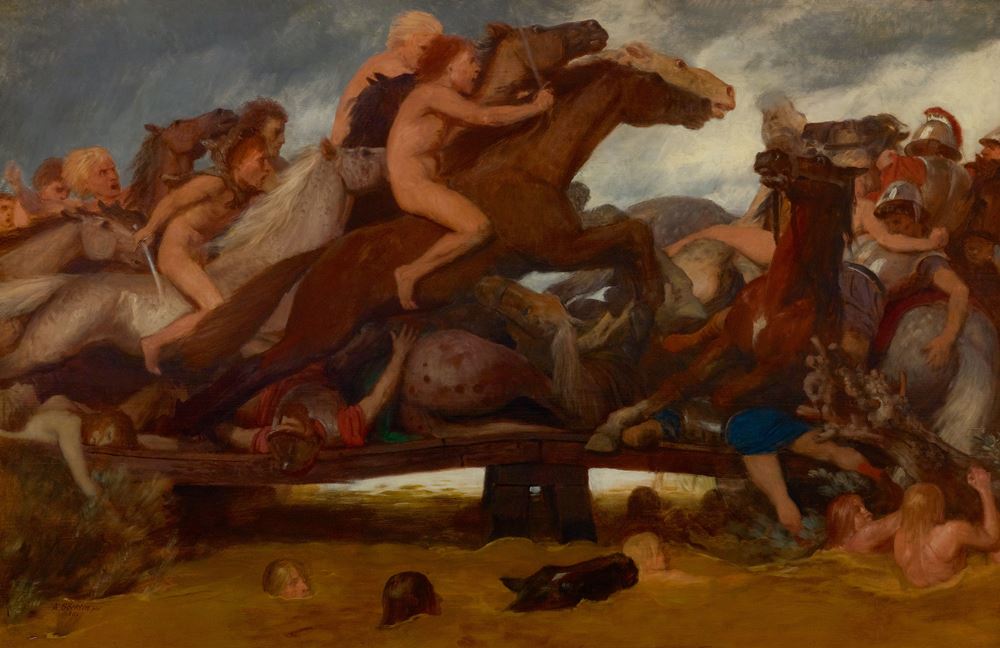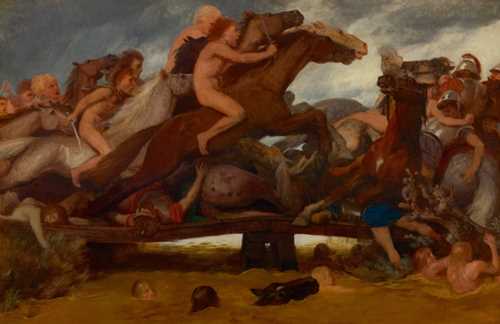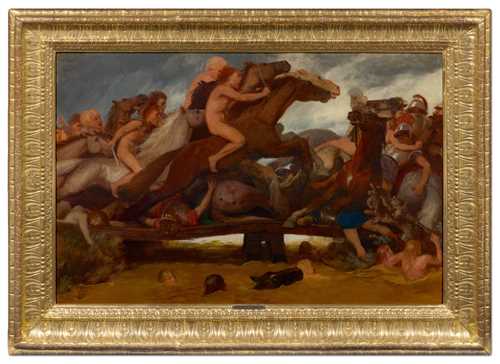
Lotto 3209 - A188 Dipinti del XIX secolo - venerdì, 29. marzo 2019, 16h00
ARNOLD BÖCKLIN
- Max Linde, Lübeck, 1897.
- Kunsthandlung Herman & Co., Frankfurt am Main, 1901.
- Martin Flersheim, Frankfurt am Main, 1907.
- Städelsches Kunstinstitut, Frankfurt am Main, 1938.
- Erben von Martin Flersheim (restored in 1950 from the Städelschen Kunstinstitut).
- Mario Uzielli, Art Trade, Basel, 1951.
- A. Weinmüller, Art Trade, Munich, 1961.
- Collection of Georg Schäfer, Obbach über Schweinfurt, until 1989.
- Merz collection, acquired from the above collection
- Via inheritance to the current owner. Swiss private collection.
Exhibition catalogues:
- Akademie-Ausstellung von Werken Arnold Böcklins zur Feier seines 70. Geburtstages. Königliche Akademie der Künste, Berlin, 2.2.1897–16.1.1898, No. 82.
- Ausstellung von Werken Arnold Böcklins, veranstaltet zur Feier seines 70. Geburtstages. Kunsthalle und Kunstverein zu Hamburg, Feb 1898, No. 37.
- Ausstellung Böcklin–Lenbach. Frankfurter Kunstverein, 19.7.–30.9.1914, No. 38.
- Gemälde und Zeichnungen von Arnold Böcklin, ausgestellt zur Feier seines 100. Geburtstages, Nationalgalerie, Berlin, 16.10.1927–5.2.1928, No. 174.
- Arnold Böcklin. Ausstellung zum Gedächtnis an seinen 50. Todestag, veranstaltet vom Basler Kunstverein und von der öffentlichen Kunstsammlung Basel, Kunsthalle Basel, 23.6.–5.8.1951, No. 113.
- Arnold Böcklin, Frankfurter Kunstverein, Steinernes Haus, Römerberg, Frankfurt am Main, 6.6.–26.7.1964, No. 42 (with ill.).
- Arnold Böcklin, 1827–1901. Hayward Gallery, London, 20.5.–27.6.1971, No. 47.
- Arnold Böcklin, 1827–1901. Kunstmuseum Düsseldorf, 21.6.–11.8.1974, No. 60 (with ill.).
- Leihgabe Kunstmuseum Lichtenstein, Vaduz, 8.11.1999–31.7.2009.
- Retrospektive Arnold Böcklin, Kunstmuseum Basel, 19.5.–26.8.2001, No. 80.
- Réunion Arnold Böcklin. Musée d'Orsay, Paris, 1.10.2001–15.1.2002.
- Retrospektive Arnold Böcklin, Neue Pinakothek, Munich, 14.2.–26.5.2002.
- Götter im Exil, Kunsthaus Graz am Landesmuseum Joanneum, 4.3.–7.5.2006.
Literature:
- Schmid, Heinrich Alfred: Verzeichnis der Werke Arnold Böcklins, München 1903, No. 360 (Der Kampf auf der Brücke, derselbe Vorwurf).
- Berger, Ernst: Böcklins Technik (Sammlung maltechnischer Schriften 1) Munich 1906, pp. 130f.
- Schmid, Heinrich Alfred: Böcklin und die Alten Meister 2, in: die Kunst, 1918, p. 240.
- Ostini, Fritz von: Böcklin, Bielefeld 1925, S. 100 und 112.
- Kleineberg, Günther: Dissertation zur Entwicklung der Naturpersonifizierung im Werk Arnold Böcklins, Göttingen 1971, p. 161.
- Wichmann, Siegfried: Arnold Böcklin, 1827–1901, Schlachten, Amazonen- und Brückenkampf, Sindelfingen 1977, pp. 12–43.
- Andree, Rolf: Arnold Böcklin. Die Gemälde, Basel 1998, No. 417, p. 487 (ill.).
On a bridge that appears to be nearly sinking into the water, two tribes meet in combat. Partly on horseback, they trample the bodies of already fallen warriors. Projecting out of the water below are overthrown combatants and a horse’s head. The warriors on the left side of the bridge are unclothed and teeming with aggression and vigour; those on the right are clothed in magnificent armour.
This museum-worthy battle scene on a bridge by the Swiss painter Arnold Böcklin was last on public view in 2006 during the "Götter im Exil" exhibition in Graz. It belongs to a series of three versions, the subjects of which were inspired by Peter Paul Rubens’ (1577 – 1640) “The Battle of the Amazons”, today located in the Alte Pinakothek in Munich (fig. 1). However, Böcklin was not interested in the glorification of Antiquity, but rather in the clash of different realities.
The version first started (Andree, Rolf: Arnold Böcklin. Die Gemälde, Basel 1998, no. 418, p. 488) was the last to be completed (fig. 3.). Presumably Böcklin was initially dissatisfied with that version and set it aside. The other two, including the one presented here (ibid., no. 416 – 417, p. 486 – 487), bear the creation date 1889. Subsequently, Böcklin probably first dealt with the large stone bridge (ibid., no. 416, p.486), now also in a private collection and recently offered on the London art market in 2012, which is more reminiscent of Ruben’s model in its sketch-like character (fig. 2.). Heinrich Alfred Schmid notes that Böcklin in that work conspicuously borrowed some of Rubens' details, such as the corpse, whose naked arm hangs down over the bridge (quoted in ibid., p. 486). However, Böcklin might also have referenced Raphael (1483 – 1520), as seen in the figure leaning on the rock on the left, recalling “The Fire in the Borgo" in the Stanze di Raffaello of the Apostolic Palace.
In our version, Böcklin chose a tighter, up-close view of the scene, underlining the brutality and savagery of the battle and the inhumanity of the barbaric event. The fight between a primeval, fair-haired (probably Germanic) tribe against a civilised, organised and dark-haired (Roman) army takes centre stage.
Undoubtedly, the choice of subject seems to have been influenced by the accepted philosophies of the period, as seen in the reference to Nietzsche's concept of the "blond beast" (published in his work "On the Genealogy of Morals", 1887). Nietzsche, seeking to turn away from what he considered a flaccid 19th-century European culture, suggested that civilisations and every emerging resentment should become a creative force dedicated to the taming of the beast.
Böcklin's "Kampf auf der Brücke" can thus be understood as a revolt of Christian morality against the alienated, oppressed masses of the Roman Empire. At the same time, the confrontation of different cultures is a timeless phenomenon.
CHF 250 000 / 350 000 | (€ 257 730 / 360 820)
Venduto per CHF 240 500 (incl. premio dell'acquirente)
Non si assume alcuna responsabilità per la correttezza di queste informazioni.


